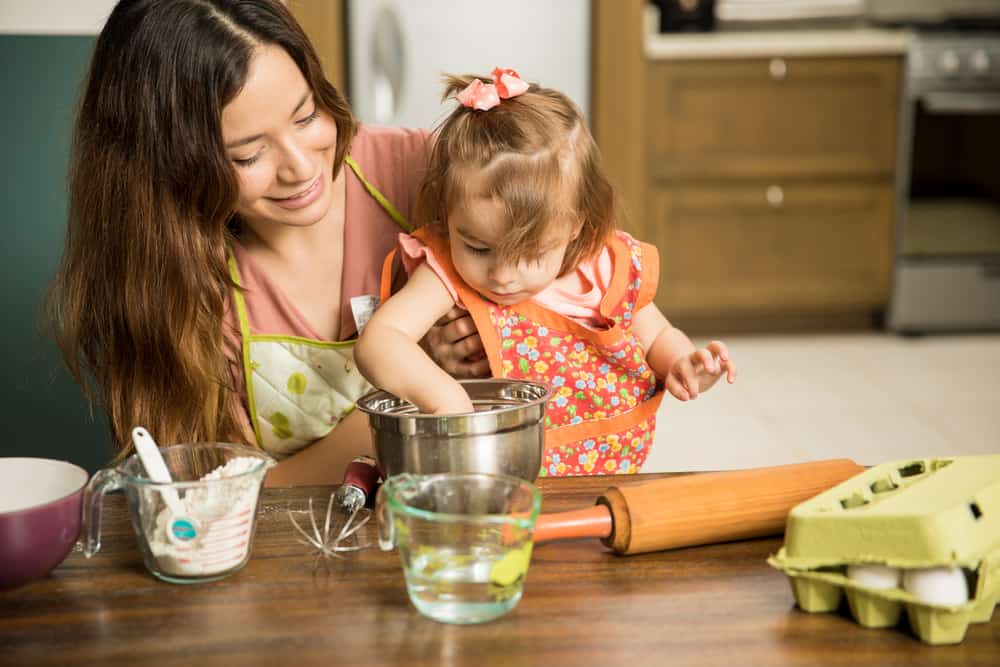Introducing your child to a varied, nutritious diet is no easy feat, especially when that tiny human seems to be equipped with the most adamant ‘no-thank-you bite’ in the universe.
If you’re nodding in parental solidarity, you’re not alone.
It’s a universal joy-and-fear ride to watch your little one’s expressions contort at the sight of a new food.
But worry not!
Here are seven interactive and fun strategies that will make your toddler trade their wariness for culinary curiosity.

(This post may contain affiliate links. To read our full disclosure policy click here.)
1. Familiarize With Foods Through Play
Exposing your toddler to new foods creates the groundwork for trying them.
You can start with non-meal times by integrating food into play.
Read stories (this is one of my favorites) or look at books about food, play “restaurant” where they ‘cook’ or ‘serve’ foods.
The goal is to remove the novelty so that it becomes a familiar sight.
2. Aisle Adventure at the Grocery Store
Turn grocery shopping into an adventure by including your little one.
Give them a mission to find a new fruit or vegetable.
Discuss the colors, shapes, and textures.
Not only does it make the food seem more approachable, but it also teaches valuable skills and autonomy.
Just hope they don’t insist on that one very expensive and totally obscure tropical fruit everyone’s talking about!
This is just one way to make grocery shopping fun with your toddler.
You can get more ideas on how to do that here.
3. The Power of Choice
Toddlers often feel like the world is a smorgasbord of adults making decisions, and they’re just here for the ride.
Combat that by offering choices about what to eat, whether it’s deciding between two different vegetables or picking out what color plate they’d like.
When they feel they have a say, they’re more likely to feel in control of their experience and be open to trying new things.

4. Encourage Food Prep Participation
Prepare foods together in age-appropriate ways.
Toddlers can wash fruits or help mix simple ingredients.
The more they handle the new food, the more likely they are to touch, taste, and explore it later.
Plus, cooking together fosters a positive relationship with food, turns meals into learning opportunities, and occupies those agile little fingers.
5. The ‘Tiny Taster’ Approach
Sometimes, less is more.
Offering a very small serving of a new food on their plate is less intimidating for toddlers.
Less of a new food feels less of a commitment, yet it still allows them to explore and engage with it.
Remember, the goal is not consumption immediately but to familiarize and reduce aversion over time.
6. Plate Anatomy of All Known Favourites
When introducing a new food, surround it with items you know they already enjoy.
This eases the introduction of the novel food by engaging with the familiar, known favorites.
It also mentally groups the new food with positive experiences and flavors they love.
Your tot might just take a bite on autopilot during the quest for their usual food.
7. The Art of Presentation
We eat with our eyes first, and that’s especially true for toddlers.
Transform a plain white plate into a canvas.
Create smiley faces with food, spell their names, or use cookie cutters to shape sandwiches.
You can even get some really fun plates like these to try.
The more creative and fun meals are, the more likely your child will be enticed to explore them.
It might even encourage outright fascination.
Patience, perseverance, and positivity are key ingredients in the recipe to expand your toddler’s palate.
Keep mealtimes stress-free, model good eating habits, and remember that every child has their own time frame for these gastronomical milestones.

Keep Meals a Positive Experience
In summary, introducing your toddler to new foods doesn’t have to be a battle of wills.
By incorporating strategies that involve play, choice, participation, and creativity, you can transform mealtime into an adventure.
From making grocery shopping an exciting exploration to engaging your child in food preparation and adopting the ‘Tiny Taster’ approach, these methods are designed to encourage curiosity and acceptance.
Remember, surrounding new foods with familiar favorites and ensuring the presentation is appealing can make a significant difference.
It’s essential to approach this process with patience, persistence, and a positive attitude, keeping mealtimes enjoyable for both you and your child.
By following these seven strategies, you’re not only promoting a balanced diet but also instilling a lifelong positive relationship with food in your toddler’s routine.
Related Posts You Will Enjoy
Why Toddlers Have Tantrums and What to Do About Them
The Best Way to Use Screen Time With Toddlers
How to Make Mornings Stress Free With Your Toddler


Kayla O’Neill has a master’s degree in education as well as a bachelor’s degree in special education with an emphasis in early childhood education. She has been working as a developmental therapist with babies and toddlers in early intervention since 2012. She is also a mom with two young children.